 A doctor is calling for a ‘pause’ on a common medical test given to millions of people each year after research found it could be contributing to America’s cancer crisis.
A doctor is calling for a ‘pause’ on a common medical test given to millions of people each year after research found it could be contributing to America’s cancer crisis.
Computerized tomography (CT) scans can be life-saving tests, used to diagnose and monitor diseases like cancer and bone injuries, as well as to assist in surgeries and evaluate the effectiveness of certain treatments.
However, experts say they are sometimes overprescribed and performed unnecessarily, potentially because of money-making opportunities for the hospitals, as the tests are very expensive (costing as much as $6,800 per scan), or out of doctors’ fears of missing a diagnosis and being sued.
There are about 93million CT scans performed annually – a number on the rise – but there is little to no regulation of the scanners and radiation levels emitted can vary widely machine to machine.
A recent research has linked CT scans to cancer, estimating the scans performed in 2023 alone could contribute to more than 100,000 cancer cases.
Now, Dr David Johnson, professor of medicine and chief of gastroenterology at Eastern Virginia Medical School, is urging doctors to reevaluate if CT scans are really in their patients’ best interests or if they are simply ‘easy and convenient.’
He said: ‘My plea is to hit the pause button on ordering CT scans just because you think it’s easy and convenient. Ask whether it’s really in the best interest of the patient.’

Glen Campbell CT Scan: CT scans are used to diagnose and monitor cancers and bone injuries
While Dr Johnson acknowledges that: ‘CT scans are a wonderful technology. There’s no doubt of that. However, we may want to consider potential alternatives.
‘We may also want to ask ourselves whether these scans are the best tools we have and ultimately whether they will change patient management.’
CT scans, which use ionizing radiation to create detailed images of the body, are not the only imaging tool doctors have at their disposal. They are best used for imaging of bones, soft tissues and organs and are frequently used for detecting tumors, fractures and blood clots.
However, Dr Johnson noted the FDA has recognized ionizing radiation as a carcinogen.

Dr David Johnson is urging doctors to reevaluate if CT scans are really in their patients’ best interests
X-rays and magnetic resonance imaging (MRI) are similar scans.
An x-ray also uses radiation – though a lower dose – to produce images of the body, but those images are less detailed.
While CT scans produce 3-dimensional images, x-rays only produce 2-dimensional images.
MRIs use no radiation.
Instead, the machines use magnetic fields and radio waves to produce detailed images of soft tissue and organs.
However, they are more expensive than CT scans (costing as much as $12,000 per scan) and take longer, which can prove fatal if images are needed right away in an emergency.
While an MRI can take between 30 and 60 minutes, a CT scan only takes about 15 minutes.
Dr Johnson first raised concerns about CT scans and cancer risk in a 2009 opinion piece published in the journal Nature.
He wrote: ‘Unfortunately, there is little cognizance among health-care providers (or their patients) about the relative latent cancer risks associated with repetitive exposure to ionizing radiation.
Given the exposure of a relatively high proportion of the population to these tests, it is incumbent on healthcare providers to have an improved understanding of these risks and discuss them accordingly with their patients.
‘The risks and benefits of these tests should be carefully analyzed and radiation exposure risk assessment should be conducted as part of the selection of diagnostic and screening tests.’
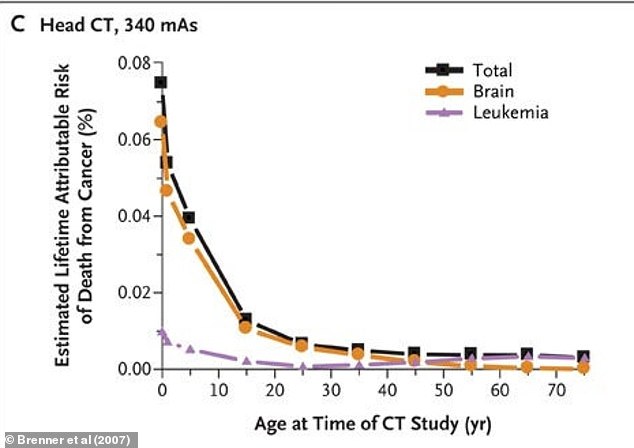
The above shows the estimated percent lifetime risk of death from cancer that is attributable to the radiation from a single CT scan of the head
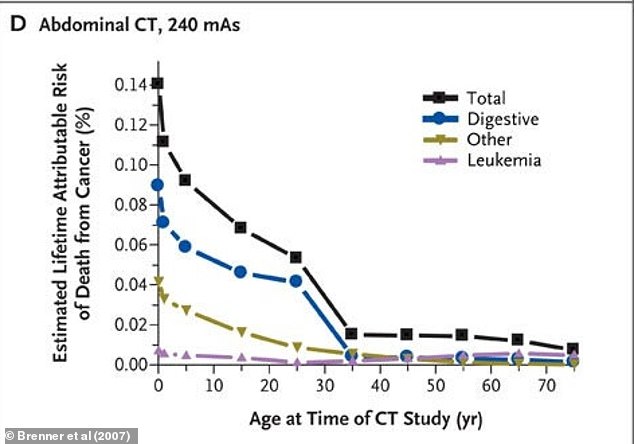
The above shows the estimated percent lifetime risk of death from cancer that is attributable to the radiation from a single CT scan of the abdomen
That same year, researchers estimated high doses of radiation from CT scans were responsible for two percent of all cancers (roughly 30,000) per year.
However, recent research estimated ‘CT-associated cancer could eventually account for five percent of all new cancer diagnoses annually.’
Last month, a study by California researchers estimated that, over the lifetime of the millions of people receiving CT scans, about 103,000 radiation-induced cancers from the scans are projected to result from tests done in 2023 alone.
Dr Johnson said in the video that the findings ‘were quite striking.’
The researchers warned CT machines emit unsafe levels of radiation that can fuel the formation of tumors.
The highest number of projected cancer cases in adults was linked to CT scans of the abdomen and pelvis, followed closely by chest CTs.
Across all patients, the most frequently associated cancers were lung, colon, leukemia, and bladder cancers.
Among female patients specifically, breast cancer emerged as the second most common type.
Dr Rebecca Smith-Bindman, a professor at the University of California-San Francisco medical school, is one of the authors of the new research.
In her new research, the team found the three most common cancers observed in exposed patients were lung cancer – 22,400 cases – colon cancer – 8,700 cases- and leukemia – 7,900 cases.
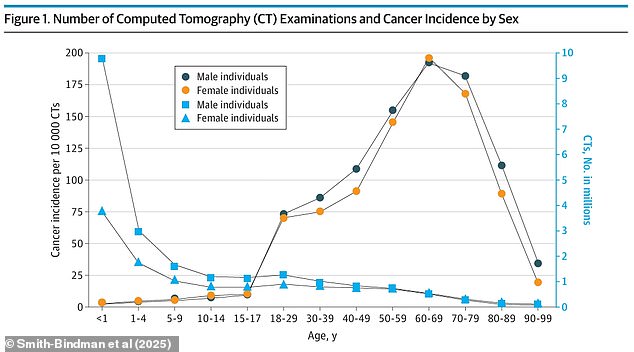
The above graph shows the number of CT scans performed in millions (right axis and blue lines) and the incidence of cancer per 1,000 CT scans (left axis and black lines)
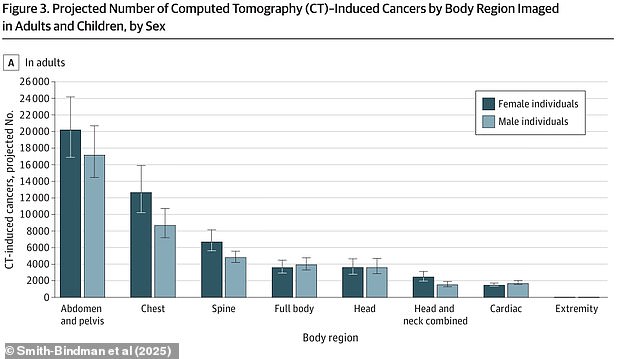
The above graph shows the projected number of CT-induced cancers by body region exposed to the scan in adults
Estimated radiation-induced cancer risks were higher in children, despite adults receiving more CTs.
Men and women experienced CT-related cancers at about the same rate across all ages and number of scans.
Cancer risk related to CT exposure was highest in people in the 60s and lowest for children under 10 years old.
Dr Smith-Bindman previously told NBC: ‘It’s unfathomable. We keep doing more and more CTs, and the doses keep going up.’
She said between two machines, one could be exposing patients to 10 to 15 times higher radiation doses than the other.
She added: ‘There is very large variation and the doses vary by an order of magnitude — tenfold, not 10 percent different — for patients seen for the same clinical problem.”
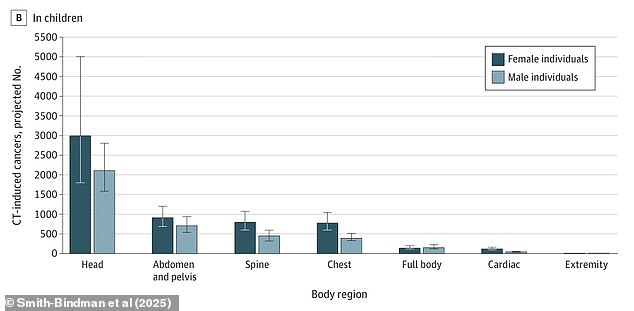
The above graph shows the projected number of CT-induced cancers by body region exposed to the scan in kids
Radiation exposure is measured in millisieverts (mSv), which measures the amount of radiation absorbed by the body.
People are exposed to small amounts of radiation every day from their background environment or through things like flying.
For example, a roundtrip flight between New York and Tokyo exposes a person to 0.19 mSv. An x-ray of the stomach emits 0.6 mSv.
The 2009 study looked at the radiation dose associated with the 11 most common types of CT scans performed on 1,119 adult patients in 2008.
Radiation exposure varied widely. Average doses ranged from 2 mSv for a head CT to 31 mSv for an abdominal and pelvic CT.
However, the researchers found the amount of radiation emitted by CT scanners varied widely across the four hospitals they collected data from – with a 13-fold difference between the highest and lowest doses for each scan type.
RELATED: CT Scans Projected to Result in 100,000 New Cancers in The US
In an attempt to tackle the problem, new Medicare regulations effective this year will require hospitals and imaging centers to collect and share information about the radiation emitted by their scanners.
The regulations also require a more careful inspection of the dosing, quality and necessity of CT scans.
The new rules, issued in the final weeks of the Biden administration, are being rolled out over three years in hospitals and outpatient clinics and providers could face fines if they do not comply, beginning in 2027.
The Trump administration has not commented on its plans to follow, revise or reverse the new policies.
Written by Alexa Lardieri for The Daily Mail ~ May 1, 2025
